Watch: 3 Ways to Make a Sequel That Doesn't Suck
In a season where sequels are being blamed for this summer's box office woes, a sequel from the summer of 1991 may chart the path back to repeated success.

For the past twenty-odd years, sequels, once the purview of a few prestige franchises (Rocky, The Godfather) and a few horror flicks with built-in audiences (A Nightmare on Elm Street 3: Dream Warriors, anyone?) have come to dominate the box office. But this year, Variety is reporting that once formidable dynasties such as Pirates of the Caribbean and Transformers have caused "the summer’s domestic ticket sales [to sink] 9% from last year."
In light of current box office trends, perhaps it would be instructive to look at one of the most successful sequels of all time, 1991's Terminator 2: Judgment Dayand see just what makes for a successful second time around. Here are 3 reasons why T2 worked, and how they apply to making a successful sequel, courtesy of this video essay from ScreenPrism:
1. "Continue, but swerve"
James Cameron once said that, "writing a sequel, you've got to continue the story, continue the characters, but you've got to swerve in a crazy direction and it has to make complete sense when you're watching it." Like the golden rule for endings (that a successful one is both inevitable and unexpected), this is, to be sure, easier said than done. But it can be done, and this is what Cameron does in T2. When Cameron told his star that in the sequel, he'd be playing the good guy, Arnold reportedly said, "But Jim, I'm the Terminator."
"You've got to swerve in a crazy direction and it has to make complete sense when you're watching it."
But it was the decision to change the character from a remorseless killing machine into, well, a remorseless killing machine with his evil switch flipped off, that opened up emotional dimensions that the first film, as a pure action adventure film, lacked. The first time around, when the Terminator arrived from the future and demanded a suitable outfit, the results were very different from the almost comic results (and lack of fatality) that occur in T2. As the video notes, audiences also have an affinity for characters like the Terminator and Spock, who aren't quite human, but try to understand our kooky ways.
2. "Bigger doesn't necessarily mean better"
T2 does things that, when it comes down to it, just weren't possible in 1984, most notably with the introduction of the T-1000's morphing "mimetic poly-alloy" worst-traffic-cop ever character. At the time, the film's $102 million budget was the most expensive in Hollywood history, but as is noted, "bigger doesn't necessarily mean better, as was proven by three more expensive yet negatively received Terminator sequels" that were to follow. Cameron's work with ILM on the T-1000 character (which featured a similar effect to one he had used in The Abyss, except the T-1000 was a major character) was huge news, but ironically, much of the effects work in the film was still done practically.
In fact, the shot immediately following the iconic "Hasta la vista, baby" catchphrase, where the T-1000 shatters into pieces, "was completed with a Stan Winston model...in fact much of the degradation of the T-1000 in the film's climax was accomplished by sculpting actor Robert Patrick in clay, pulling the model apart and creating a foam rubber puppet model." Most surprisingly, T2 only has 47 CGI shots, compared to "about 1200 in Terminator Genisys."
3. Raise the budget, raise the stakes
So where did all that money go to? Well, yes, it went into a lot of explosions (they just happened to be real ones, not CGI). But what differed so much in T2 was the scope of the film. Where the first film was a straight action movie, in the sequel we get far more plot and many more ideas. It's a more complex universe than the first; here we are introduced to a world that "expressed timely social fears of surveillance, drone warfare and of course, artificial intelligence, anxieties that have grown all the more pervasive and relevant" since the film was made. The added money allowed Cameron to explore the origins of the A.I. technology that would take over the world and the very human minds (minds with nothing but benevolent intent, but isn't that always the case?) behind the rise of Skynet.
My father has often expressed his feeling that the sequel to the Godfather is, in many ways, superior to the first, and many people share his opinion. The reasons are, surprisingly (or unsurprisingly, depending on your view) much the same. Coppola used his newfound power and budget to expand the story of the Corleone family, to "continue, but swerve" with the characters, as the story focused on Michael's Shakespearean shift from good to evil, an entire parallel story starring Robert De Niro and a global view of the enterprise that would corrode his soul.
There's nothing inherently wrong with sequels, but they have to be more than just a new gimmick, or a cameo. When studios become complacent, audiences vote with their dollars, and this lesson applies to every filmmaker, especially indie ones. A great story has limitless potential, and can move in many directions. The important thing is to take it where it needs to go. If you do, people tend to show up to see what happens next.











